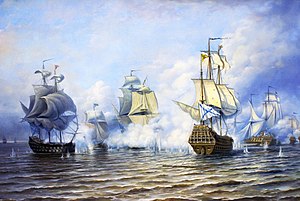Sea battle at Ösel
| date | June 4, 1719 |
|---|---|
| place | Near the island of Ösel , today's Estonia |
| output | russian victory |
| Parties to the conflict | |
|---|---|
| Commander | |
| Troop strength | |
| three ships | seven ships |
| losses | |
|
three captured ships |
nine dead and nine wounded |
1st phase: Swedish dominance (1700–1709)
Riga I • Jungfernhof • Varja • Pühhajoggi • Narva • Pechora • Düna • Rauge • Erastfer • Hummelshof • Embach • Tartu • Narva II • Wesenberg I • Wesenberg II
Arkhangelsk • Lake Ladoga • Nöteborg • Nyenschanz • Neva • Systerbäck • Petersburg • Vyborg I • Porvoo • Neva II • Koporje II • Kolkanpää
Vilnius • Salads • Jacobstadt • Walled Courtyard • Mitau • Grodno I • Olkieniki • Nyaswisch • Klezk • Ljachavichy
Klissow • Pułtusk • Thorn • Lemberg • Warsaw • Posen • Punitz • Tillendorf • Rakowitz • Praga • Fraustadt • Kalisch
Grodno II • Golovchin • Moljatitschi • Rajowka • Lesnaja • Desna • Baturyn • Koniecpol • Weprik • Opischnja • Krasnokutsk • Sokolki • Poltava I • Poltava II
2nd phase: Sweden on the defensive (1710–1721)
Riga II • Vyborg II • Pernau • Kexholm • Reval • Hogland • Pälkäne • Storkyro • Nyslott • Hanko
Helsingborg • Køge Bay • Gulf of Bothnia • Frederikshald I • Dynekilen Fjord • Gothenburg I • Strömstad • Trondheim • Frederikshald II • Marstrand • Ösel • Gothenburg II • Södra Stäket • Grönham • Sundsvall
Elbing • Wismar I • Lübow • Stralsund I • Greifswalder Bodden I • Stade • Rügen • Gadebusch • Altona • Tönning II • Stettin • Fehmarn • Wismar II • Stralsund II • Jasmund • Peenemünde • Greifswalder Bodden II • Stresow
The sea battle at Ösel was a naval battle in the Great Northern War . It took place on June 4, 1719 near the island of Saaremaa (Ösel). The Russian captain Naum Akimowitsch Senjawin forced three Swedish warships (two frigates and one brigantine ) to surrender the ships without having to board them. The commander of the Swedish association, Anton Johan Wrangel , was captured.
In advance
In May 1719, three ships of the Swedish Navy under the command of Captain Wrangel Pillau left to escort a Swedish convoy from Stockholm .
The Russian Navy learned of this project and sent a fleet under Captain Senjawin to intercept these ships. He left Reval (now Tallinn ) with his seven-ship fleet on May 26th .
Ships involved
The Swedish squadron
- Flagship Wachtmeister - 40 guns
- Frigate Karlskrona Vapen - 34 guns
- Brigantine Bernhardus - 10 guns
The Russian fleet
- Flagship Portsmouth - 52 guns
- Ship of the line Devonshire - 52 guns
- Ship of the line Uriel - 52 guns
- Raphael ship of the line - 52 guns
- Frigate Yagudiil - 52 guns
- Frigate Varahail - 52 guns
- Schooner Natalia - 18 guns
Course of the battle
In the early morning of June 4, around 3:00 a.m., the two squadrons met in the waters west of Saaremaa Island . Wrangel realized that the Russian Federation was far superior to his. So he turned to the north-west to avoid a fight. The Russian ships chase without first knowing who they were chasing as the Swedish ships did not fly flags. The flagship Portsmouth and the liner Devonshire took over the command of the Russian squadron.
At five in the morning the Russian unit caught up with the Swedish ships and fired two warning shots to force the foreign commander to show the flag. When Wrangel hoisted the Swedish flag , the Russian gunners opened fire immediately.
The ships of the line Portsmouth and Devonshire tried to separate the flagship Wachtmeister from the others. This duel took place from 5:00 a.m. to 9:00 a.m. The sergeant's gunners fired at the Devonshire , causing their sails to catch fire. The Portsmouth turned to the frigate Vapen Karlskrona , which was far inferior to the Portsmouth . The Russian guns inflicted such severe damage on the frigate that after only a brief bombardment it withdrew its flag and surrendered. The third ship of the Swedish squadron, the Bernhardus , was also separated from the flagship and came under fire. The commander surrendered after a short battle.
The sergeants, however, fought their way free and initially escaped the Russians. She tried to pull away in the direction of the Swedish island of Gotska Sandön . This route was blocked to the Swedes by the Raphael and the Yagudiil .
The Swedish commander Wrangel was badly wounded in the battle, so that his first officer Trolle had taken command of the flagship. He refused to hand over the ship. 15 hours after the start of the sea battle, the Russian ships launched the final attack on the Swedish flagship. The sergeant was completely dismasted and the upper deck was littered with dead and wounded. The first officer Trolle recognized the hopelessness of the situation and handed the ship over to the Russian commander.
With the Swedish squadron in tow, the Russian fleet headed for Reval. This success was one of the first victories in young Russian maritime history in an open sea battle.
literature
- RC Anderson: Naval wars in the Baltic , Gilbert-Wood, 1910 (English)
- Guy Le Moing: Les 600 plus grandes batailles navales de l'histoire , Marines Éditions, 2011, ISBN 978-2-35743-077-8 (French)

